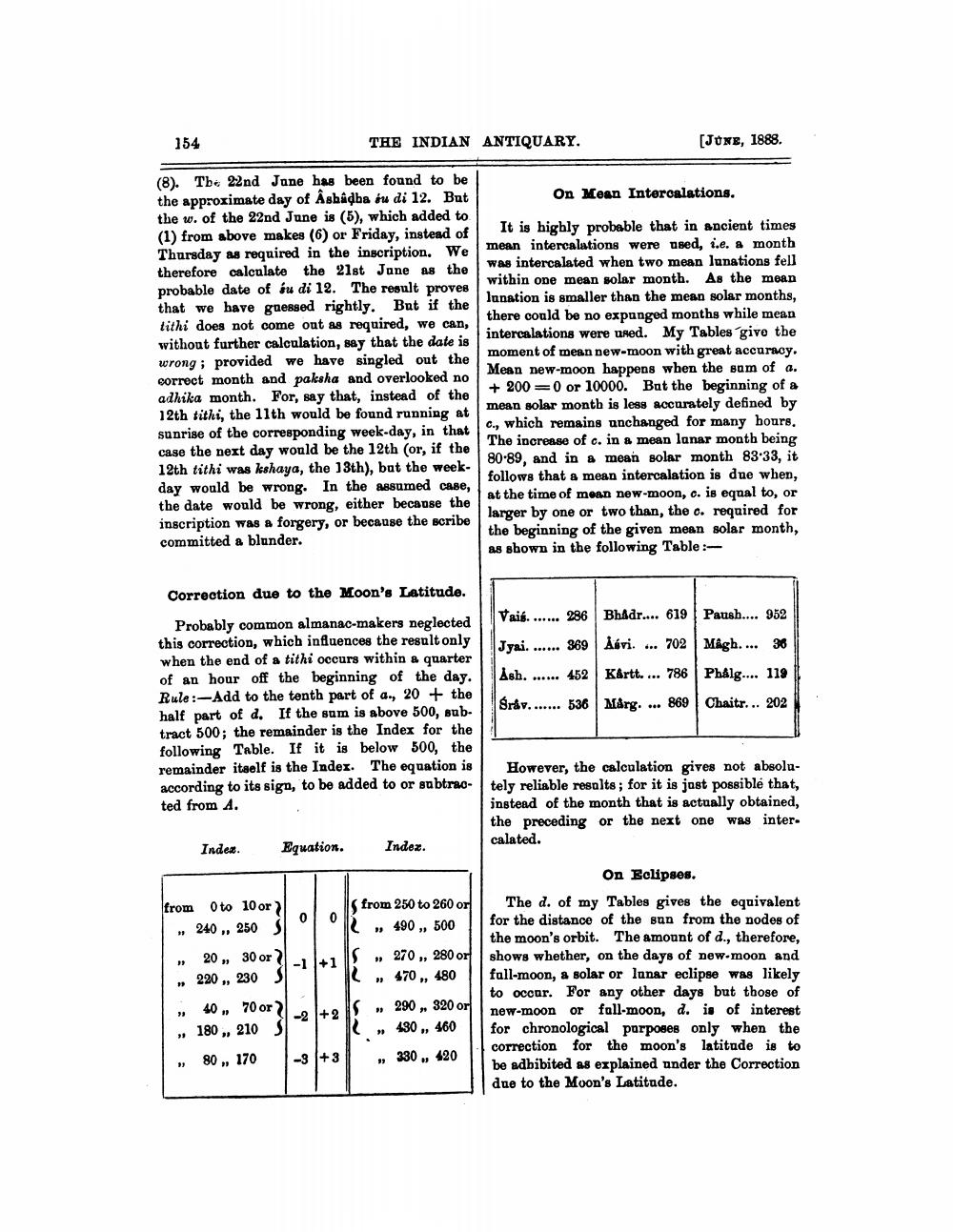________________
154
THE INDIAN ANTIQUARY.
[JUNE, 1888.
(8). The 22nd Jane has been found to be the approximate day of Asbadba bu di 12. But the w. of the 22nd June is (5), which added to (1) from above makes (6) or Friday, instead of Thursday as required in the inscription. We therefore calculate the 21st Jane as the probable date of bu di 12. The result proves that we have guessed rightly. But if the tithi does not come out as required, we can, without further calculation, say that the date is wrong; provided we have singled out the correct month and paksha and overlooked no adhika month. For, say that, instead of the 12th tithi, the 11th would be found running at sunrise of the corresponding week-day, in that case the next day would be the 12th (or, if the 12th tithi was kshaya, the 13th), but the weekday would be wrong. In the assumed case, the date would be wrong, either because the inscription was a forgery, or because the scribe committed a blunder.
On Mean Intercalations. It is highly probable that in ancient times mean intercalations were used, i.e. a month was intercalated when two mean lanations fell within one mean solar month. As the mean lanation is smaller than the mean solar months, there could be no expunged months while mean intercalations were used. My Tables give the moment of mean new-moon with great accuracy. Mean new-moon happens when the sum of a.
+ 200 =0 or 10000. Bat the beginning of a mean solar month is less accurately defined by c., which remains unchanged for many hours. The increase of c. in a mean lanar month being 80-89, and in a mean solar month 83.33, it follows that a mean intercalation is due when, at the time of mean new-moon, o. is equal to, or larger by one or two than, the c. required for the beginning of the given mean solar month, as shown in the following Table :
Vais....... Jyai.......
Correction due to the Moon's Latitude.
Probably common almanac-makers neglected this correction, which influences the result only when the end of a tithi occurs within a quarter of an hour off the beginning of the day. Rule:-Add to the tenth part of a., 20 + the half part of d. If the sum is above 500, Bubtract 500; the remainder is the Index for the following Table. If it is below 500, the remainder itself is the Index. The equation is according to its sign, to be added to or subtraoted from A.
48h. ....
Patish.... 952 Mágh.... 30 Phålg.... 119 Chaitr... 202
Aúvi. ... 702 Kartt. ... 786 Mårg. ... 869
Sráv.......
However, the calculation gives not absolutely reliable resolts; for it is just possible that, instead of the month that is actually obtained, the preceding or the next one was intercalated.
Index.
Equation.
Indoz.
from 0 to 10 or 1 , 240, 250 $ , 20, 30 or 1+1
220 ,, 230
40, 70 or ? , 180, 210 S , 80,, 170 -3 +3
from 250 to 260 or R , 490, 500 S , 270, 280 or 470, 480
320 or
On Eclipses. The d. of my Tables gives the equivalent for the distance of the sun from the nodes of the moon's orbit. The amount of d., therefore, shows whether, on the days of new-moon and fall-moon, a solar or lunar eclipse was likely to occur. For any other days but those of new-moon or foll-moon, d. is of interest for chronological purposes only when the correction for the moon's latitude is to be adbibited as explained under the Correction due to the Moon's Latitude.
130, 460
330., 420




